


Introduction
It has long been recognised that the name that appears on an instrument may not be the actual manufacturer but may only be the retailer. Where the name that appears is the name of a well known manufacturer, but not the one that made the instrument, then this is clearly going to lead to confusion. This practice was actually significantly more prevalent than is generally understood. To fully understand how wide it was requires a lot of research in contemporary manufacturers' literature and painstaking comparison of instruments and sets.
Then there are the vast numbers of sets and individual instruments that have no makers' name, nor even that of the retailer. Many of these were cheap imported sets sold to students, and many of the major manufacturers, such as Thornton and Halden, sold these instruments alongside those of their own manufacture.
In this section I have attempted to unravel some of the mysteries but there are many more that defy my efforts.
An Interesting Interview
In the autumn of 1998, I appeared with my collection on the Channel 4 TV Programme "Collectors' Lot". This provoked quite a lot of interest and among the letters which I received was one from Mrs. Betty Lamerton who had been an instrument maker for 42 years for J J Threadwell & Sons Ltd. until the firm closed and she retired in 1986. She offered to sell me some samples of the instruments made by Threadwell and I arranged to visit her to view them. Before the visit she sent me some photocopies of their pre-war and early post-war catalogues. I was immediately struck by the resemblance of their instruments to some in my collection, (a) in a Charles Baker set, and (b) some loose instruments, stamped "Stanley" (a photo of these appears in the W F Stanley page), which were in fact identical to ones in the Baker set. I had also seen them stamped "G.P.O.". I mentioned this to Mrs. Lamerton and she immediately confirmed my suspicions. They had all been made by Threadwell and she was able to show me some documentary evidence of this. Threadwell even had "Stanley" stamps for marking the instruments.
I also noted that none of the Threadwell instruments that she had was stamped, nor were any of the cases.
Literature
A few years ago I purchased from The Manchester Library and the Greater Manchester Museum of Science & Industry photocopies of a number of items of Halden and Thornton trade literature. Of particular relevance are:
J Halden & Co, 1902 Catalogue
J Halden & Co, 1910 Catalogue, Part A
A G Thornton, 1895 Catalogue
Mathematical Drawing Instruments and Materials by A G Thornton, pub. Percival Marshall
Reference A is a detailed catalogue of over 120 pages. Apart from the comprehensive illustrated lists of the items they sold it also contains photographs of the interior and exterior of their various shops and factories. Although most of the drawing instruments shown would have been of their manufacture the catalogue commences with some cheaper sets intended for students. Case 66, illustrated on Page 1 was almost certainly made elsewhere, possibly overseas. Identical or similar sets also turn up marked with the names of several retailers such as The Scholastic, Bristol and Jackson Bros, Call Lane, Leeds. The key is the wording of the page title “Drawing Instruments Specially Selected for Engineer Pupils, Students in Science and Arts Classes, &c.”
Pages 2 and 3 illustrate “The New Model Drawing Instruments”. The compasses and dividers, in this instance, are to a design patented, and probably manufactured, by Riefler of Germany. Is it a coincidence that on page 4 they list “High-Class German Drawing Pens”.

The maker of many sets of instruments and individual items is not who it seems at first sight from the name that appears on the case or instrument. In this section I look at some of the evidence that supports this statement, from catalogues and books, from actual instruments, and from discussions with former instrument makers.
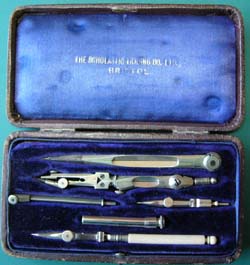
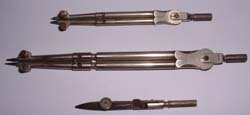
The Scholastic Trading Co., Bristol - one of the sets by an unknown maker that can be found with the stamp of several retailers and which appeared in Halden's 1902 catalogue.
Riefler round pattern compasses of the same design as the Halden New Model and Thornton’s “Kinwest” (1916 Thornton catalogue).
On page 6 they are quite specific “Cases of Drawing Instruments Best English Manufacture” and they continue to head following pages “English Made Instruments”. All the instruments in these pages are to what is frequently called the “Old English Pattern” made by most of the British manufacturers at that time.
In page 15 there are two Faber’s Patent Pens listed. In pages 17 and 18 they clearly distinguish between English and Swiss made Napier compasses. Page 20 lists and illustrates “Amsler Planimeters” which would almost certainly have been made in Switzerland by Amsler.
Turning to the 1910 catalogue (ref B) there is yet more evidence on pages 4 and 5 which list and illustrate “English Pattern Drawing Instruments Best Foreign Manufacture”. In spite of the title description the pens are clearly different in details such as the handle finial, the ferrule and the opening nib joint from those made in Britain. The No 786a Rotating spring bow illustrated was probably German. I would like to know the source of the other instruments illustrated.
Ref C has over 130 pages. The catalogue starts on page 5 with “Loose Drawing Instruments; Half Sets of Compasses – English Make”. Page 15, however, exhibits a significant change to the wording which becomes “.....English Make, &c.” Pens 3459 and 3471½ are clearly Faber patent ones although not identified as such.
Page 17 describes a “Special Line in Loose Drawing Instruments. English Make. German Silver.......by far the cheapest for the make and quality offered” More specifically it also states “Instruments are made in my own factory on the premises.” At this time Thornton quoted that his best instruments were made in Electrum. Both Electrum and German Silver are copper/nickel/zinc alloys having a similar appearance but I do not know how their chemical compositions differed; possibly German Silver contained more copper and less nickel and hence was significantly cheaper. One composition for German Silver that I have seen is 60% Cu, 20% Ni, 20% Zn, whilst I have also seen a composition for a good Nickel Silver as 46% Cu, 34% Ni, 20% Zn. Was the best quality Electrum similar to this?
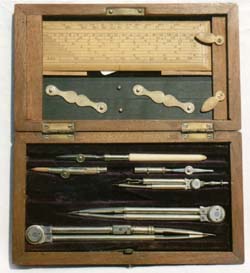
A patent set by James Parkes of Birmingham, of the same type as described in Thornton's book, ref D.
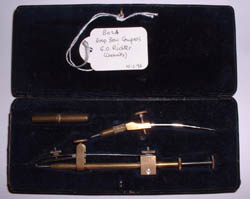
Richter Rotating (or drop bow) compass of the same type as illustrated in the Thornton 1895 catalogue and in Thornton's book
Page 19 describes beam compasses and includes no 3498 “Swiss made”. From this page on “English make” is generally specified against individual items. Where it isn’t it might be assumed that they are of foreign manufacture. On page 31 item no 3510 Patent Rotating Compass is clearly a Richter (German) design – I have one signed Richter in my collection. Richter’s trade mark even appears between the words “Patent” and “Rotating” in the Thornton catalogue.
It should also be noted that both Halden and Thornton advertised that they would make cases to order to suit any selection of instruments and hence such cases could contain instruments of both their own and other firm’s manufacture. Many firms would even make cases to include instruments they hadn’t sold so the name in the lid of a case is not necessarily the maker of all of the instruments even if it is for the majority.
Pages 42 and 43 are devoted to “Cheap (Foreign) Drawing Instruments”. Most of these are brass. The cheapest of these, priced 1/- to 4/6, were clearly intended for school use. I have a number of these cheap, foreign sets in my collection. There is no indication as to where they were made but from their general appearance I think that it was probably France.
Reference D is a book by A G Thornton comprising over 250 pages which describes the various types of instrument and their technical features in great detail. For instance it discusses the various types of compass head joint and advises which is best. Page 32 describes a “Half-set, tubular form, English make” as “strongly made ...... sold at a cheap price .... in good demand.” From the description one may conclude that Thornton did at one time sell these instruments that were patented and made by James Parkes of Birmingham. The same pattern of dividers are shown on page 35 and the bow compass is described on page 42.
On page 48 the same rotating compass as catalogued on page 31 of the 1895 catalogue is shown and described. It is here stated to be “foreign”. The swivel or curve pen (catalogue item 3459) is confirmed to be German and item 3471½ is stated to be foreign. The book also describes various other patent pens such as the sliding blade pen which is again stated to be foreign. The last illustrated is the Universal Dotting Pen, a mechanical pen in which the nib is lifted and let down by a rotating cam wheel. The illustration of this “German patent” pen clearly shows the Richter trade mark above the word “patent”. As the instructions for its use are given it is likely that Thornton sold these pens in Britain. I do know that Thornton sold flat pattern sets by E O Richter prior to the first world war as I have an example, which is shown on the Richter page.
There is clearly enough evidence in these references that all that the manufacturers sold was not necessarily made by them.
Evidence from the Examination of Instrument Sets
This is much more circumstantial. Many makes of both traditional pattern and flat pattern instruments superficially resemble each other. To be sure that two sets of instruments were actually made by the same manufacturer they must match in all details, including exact sizes, and compass inserts, screws and other removable parts must be fully interchangeable without being either loose or too tight.
My first example is a Halden “Premier” set. The set comprises a compass half set, dividers, three spring bows, a pen handle and a screwdriver all of which exactly match the corresponding Thornton Minerva instruments, even down to such unusual features as the vee at the end of the slot in the peg of the inserts and the vee shaped knurling on the adjusting wheels of the spring bows. All were stamped “Halden” where they would otherwise have been stamped “Thornton”. The ivory handled pens in the set were, however, probably of Halden manufacture.
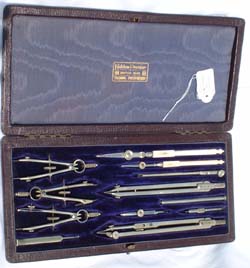
A Halden Premier set - made by Thornton?
The next example is a set of instruments in a wallet case on which is printed the name of J H Steward Ltd of London. This is a full set of instruments, which includes large and small compasses, dividers, three spring bows and two ruling pens. These exactly match the corresponding Thornton Techset instruments, this time including the pens and even the wallet case which has the same covering materials and the characteristic Thornton green felt interior. Again the characteristic vee at the end of the slot in the peg of the inserts is present.
Both these sets of instruments were almost certainly made by Thornton with the exception of the Halden Premier pens and probably the Halden case.
Halden did make their own range of flat pattern instruments but these were not of the same, high quality as the Thornton Minerva ones.
Returning to catalogue evidence, B J Hall & Co describe in their 1930 catalogue their “Simplex” range of instruments which are clearly identical to Thornton’s Minerva range. The illustrations and introductory text are also the same as in Thornton’s 1940 catalogue. The Simplex series includes a ‘Universal Roller Beam Compass (Gill’s Patent No. 155970/19)’. On my page of Thornton instruments I have illustrated and described one of these, ex UK government, which is entitled on the lid of its case ‘Compasses Beam 26” T.P. (Thornton Pattern)’. However the instrument is not marked Thornton anywhere but is just stamped with the patent number. It is also brass rather than the nickel silver described in the Hall catalogue. Hall certainly give the impression in their catalogue that they made the Simplex series and also their “Abbey” series, which are the spitting image of Thornton’s ‘Techset’ ones. They also list ‘Jaywess’ instruments, this time using the same name as Thornton. Did more than one manufacturer make the same instruments, possibly under licence?
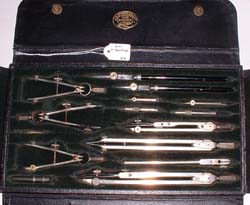
The J H Steward set which was almost certainly made by Thornton as it is identical to one in their Techset range.

The set of Rowney spring bows that I concluded were made my W F Stanley.
My third example is a cased set of three traditional pattern spring bows. The case has “G. Rowney & Co London” in gold letters on its underside. Rowney were makers of artists’ materials but would, almost certainly, have bought in drawing instruments for sale by them. In this case the solution lies in the very unusual style of the knurling on the handles which matches that of a set illustrated in Michael Scott-Scott’s book on drawing instruments published by Shire Publications. He states that the instruments were made by Stanley and I would therefore conclude that the “Rowney” set were also.
W H Harling also made a distinctive range of instruments available in two qualities, the standard “British Empire” ones and their “Technical Series” and these are described in their 1930 catalogue. Some of these instruments continued to be made into the 1960s. The catalogues of C F Casella & Co (1930s), A West & Partners (1930/5) and Instruments Ltd (Canada) (1947) also show these instruments, in many cases using the same illustrations with the name blanked out or their name substituted. Casella describes these as “the new patterns approved by the Inter-Departmental Committee appointed to consider the design of British drawing instruments” so they would appear to be a standard design made by more than one company; however Harling seem to have been a major manufacturer and supplied many sets to the UK government. A G Thornton and W F Stanley also supplied “British Empire” series instruments to the government. The ones sold by Instruments Ltd were made in Britain but the catalogue does not state who by.
| Early Sets |
| Traditional Sets |
| Later Sets |
| Major Makers |
| Instruments |
| Miscellanea |
| W F Stanley |
| A G Thornton |
| W H Harling |
| Elliott Bros |
| J Halden |
| Riefler |
| E O Richter |
| Kern, Aarau |
| Keuffel & Esser |
| Compasses |
| Pocket compasses |
| Beam compasses |
| Dividers |
| Proportional dividers |
| Pens |
| Pencils |
| Rules |
| Protractors |
| Squares |
| Parallels |
| Pantographs |
| Sectors |
| Planimeters |
| Map Measurers |
| Miscellaneous |
| Materials Used |
| Who made them |
| Who made these |
| Addiator |
| Addimult |
| Other German |
| USA |
| Miscellaneous |
| Microscopes |
| Barometers |
| Hydrometers & Scales |
| Pedometers |
| Surveying Instruments |
| Other instruments |
| Workshop Measuring Tools |
| Catalogues & Brochures |
| Micrometers & Verniers |
| Engineering rules and gauges |
| Wood rules & calipers |
| Dial gauges & miscellaneous |